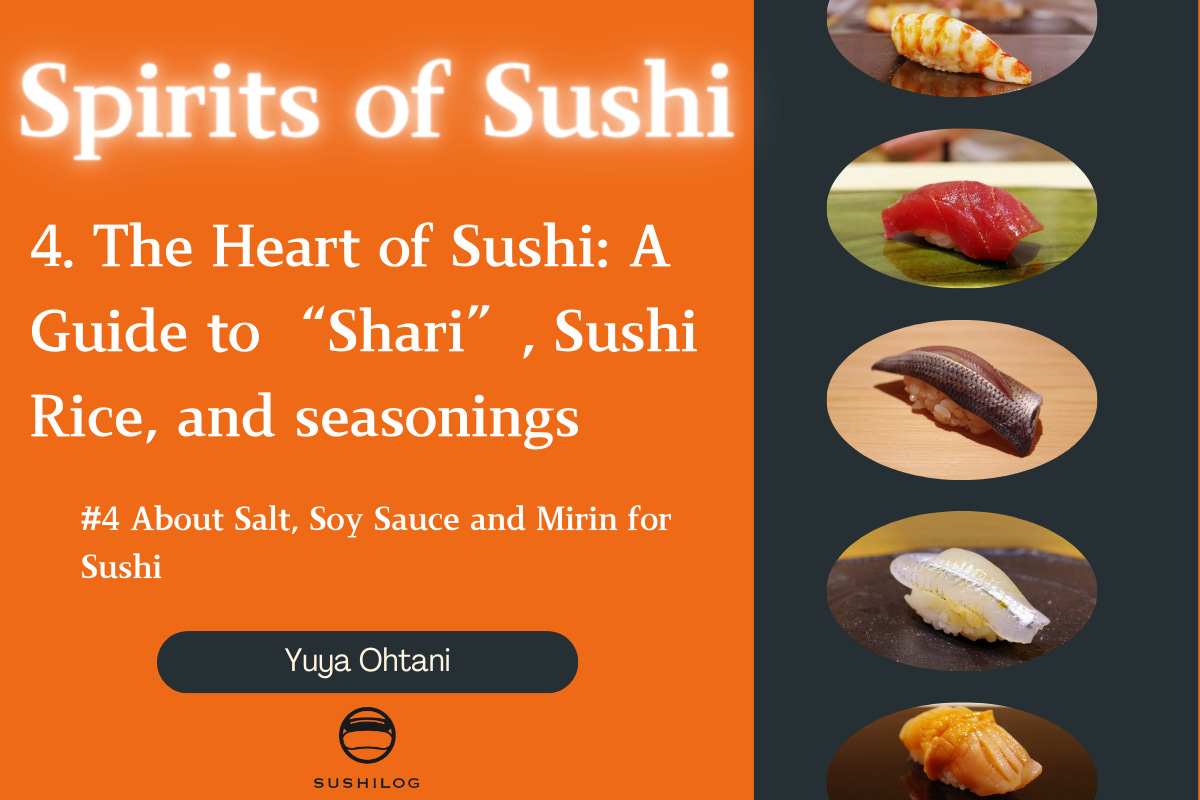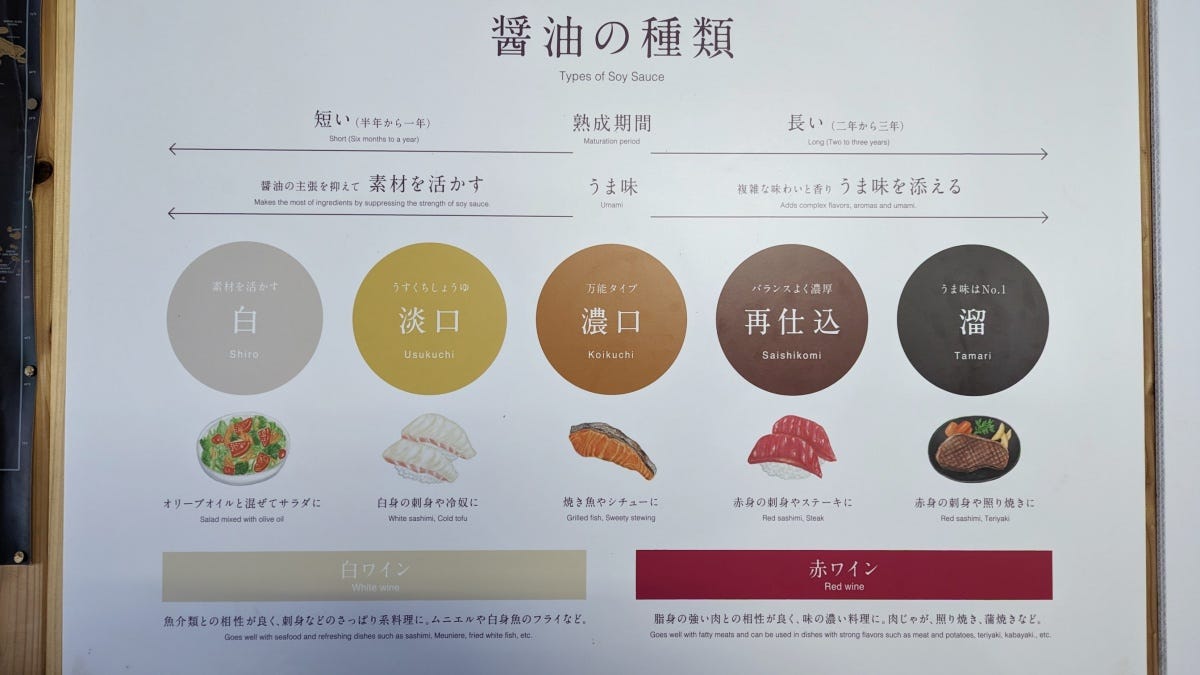4. The Heart of Sushi: A Guide to “Shari”, Sushi Rice, and seasonings
#4 About Salt, Soy Sauce and Mirin for Sushi
The next article will delve into the significance of seasonings such as salt, soy sauce and mirin. Just as with the cuisines of all countries, seasonings play a crucial role in defining the flavor of a dish, and the finest chefs are meticulous in their selection.
About Salt for Shari
I can confidently say that there can be no good sushi without good salt. Salt is a crucial seasoning for sushi rice, and essential for properly preparing the fish. Just as chefs in Europe's starred restaurants meticulously select their salt, Japan's top sushi chefs are equally careful in choosing theirs. The primary difference lies in the type of salt preferred: sea salt is commonly used in Japanese cuisine, while rock salt tends to be more prevalent globally.
Historically, Japan has practiced the “salt beach method” since ancient times.
During the Edo period (1603-1867), “irihama”-style salt fields were developed in the Seto Inland Sea, only to be discontinued with the introduction of the salt monopoly system in 1905. This system was implemented due to the low production and inconsistent quality of salt at that time, lasting for 92 years until its liberalization in 1997, with full liberalization occurring in Japan only in 2002. Since then, there has been a resurgence in sea salt production across Japan, leading to a “natural salt boom”. It's estimated that Japan now has over 4,000 varieties of salt, including those imported.
The choice of salt varies depending on each sushi chef's vision for their ideal sushi rice. From my experience, sea salt from Okinawa, seaweed salt from the Seto Inland Sea, and salt from the Irihama salt fields in Oku-noto are frequently chosen. Notably, seaweed salt, a unique Japanese product, is made by repeatedly soaking seaweed in seawater, drying it, and then boiling the brine to produce salt. This method infuses the salt with the flavor components of the seaweed, resulting in a salt with a rich flavor profile.
Soy Sauce: A Key Seasoning for Sushi
Soy sauce, shoyu in Japanese, is a crucial seasoning not just for sushi but across Japanese cuisine. A key component in sushi preparation is “nikiri shoyu”, a type of soy sauce applied as a finishing touch. “Nikiri shoyu” is created by boiling sake or mirin to remove the alcohol, then mixing this with soy sauce, yielding a concoction unique to sushi. In sushi establishments, a clear distinction exists between “nikiri shoyu” and “ki-joyu” (soy sauce that is not mixed with any other seasonings). While “ki-joyu” might be used for conveyor-belt sushi or in home settings, the majority of top-tier Edomae-zushi restaurants prefer “nikiri shoyu”.
Identifying high-quality soy sauce is relatively straightforward. Soy sauce produced exclusively from “Japanese whole soybeans, Japanese wheat, and salt” signifies a product of high quality and dedication. In contrast, mass-produced soy sauces are easily recognizable by their inclusion of ingredients like “foreign non-fat processed soybeans” alongside other additives such as “amino acid solution, caramel coloring, sweeteners, and preservatives”.
Soy sauce crafted through diligent, traditional methods offers a distinct aroma and richness unattainable in mass-produced versions. The complex scents from fermentation and aging stimulate the appetite, while the flavor is both rich and nuanced. Given the bland and synthetic taste of mass-produced soy sauce, sushi restaurants and connoisseurs prefer high-quality variants. For those purchasing souvenirs in Japan, selecting soy sauce made with the aforementioned premium ingredients is advisable.
Mirin: An Essential Seasoning for Sushi
Mirin, a traditional Japanese seasoning, plays a crucial role in adding sweetness to sushi and other Japanese dishes. While there exists a range between high-quality and mass-produced mirin, traditional Hon-mirin is the type that ought to be used in sushi restaurants. Hon-mirin's ingredients include “rice malt, shochu, and glutinous rice”. In contrast, mirin-like seasonings are made from “syrup, brewing seasonings of rice and rice koji, vinegar, and acidifiers”. Unlike sake, mirin does not undergo fermentation. It is created through the saccharification process, utilizing koji's enzymatic action, mixed with shochu, and then aged over a long period.
Among the various types of mirin, “Fukuraijun” produced by Hakusen Shuzo in Gifu Prefecture is recognized for its high quality. Many mirin-like seasonings available in Japan may not be palatable when tasted directly, but “Fukuraijun” is enjoyable even on its own. Considering this, it's illogical to suggest that a seasoning meant for culinary use should taste unpleasant in its natural state. The distinction in flavor that high-quality mirin brings to cooking is palpable and significant.
This brings us to the end of this chapter. Coming up next, we'll dive into the world of Sushi ingredients – a topic many of you have eagerly anticipated. “I've been waiting for this!” might be a sentiment shared by many. Rest assured, the upcoming chapter is designed to meet, if not exceed, your expectations. Stay tuned and look forward to it!
If you enjoy this article, please share it on your social networks. Your support inspires me to keep writing!
The TOC of “Spirits of Sushi“
Introduction: Unveiling Sushi Secrets
The History of Sushi
Exploring Sushi Varieties: Edomae-zushi (Nigiri-zushi), Kansai-zushi, and More
Essential Sushi Vocabulary: Key Terms for Navigating a Sushi Restaurant
The Heart of Sushi: A Guide to “Shari”, Sushi Rice
A Deep Dive into Sushi Fish and Accompaniments
The Art of the Sushi Master: Traditional Japanese Knives
Japan's Exquisite Fish Culture: From Tsukiji to Toyosu Market and Various Regions
Must-Visit Sushi Restaurants: From Tokyo to Sapporo, Fukuoka, and Other Regions
Regional Sushi Styles: Exploring Japan's Diverse Sushi Culture
Sushi and Sake Pairings: A Culinary Adventure
Sushi Etiquette and Table Manner: Dining like a Sophisticated Local
Shopping in Japan: Essentials for Crafting Delicious Sushi at Home
Sushi in Pop Culture: Manga and Movies
Sushi: A Lens on Health and Sustainability
Wrapping Up: The Future of Sushi







